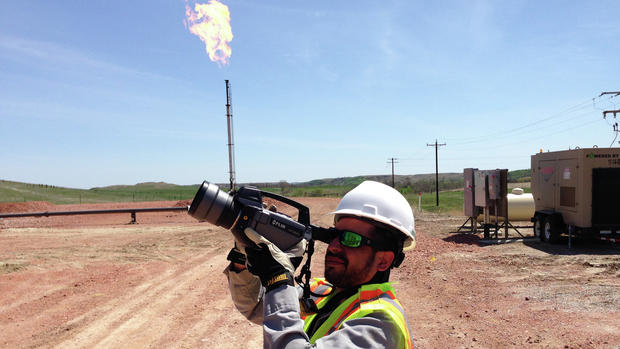Air Pollution in North Dakota, an Oil and Coal State, Is Down 25 Percent Over the Last Five Years

Renè Heredia Nieves, environmental scientist with the North Dakota Department of Health, uses a FLIR camera to inspect a well site north of Killdeer, N.D., on Thursday, May 5, 2016. Photo courtesy of Department of Health
To hear some environmental activists put it, you’d think North Dakota were an industrial wasteland where energy industry titans are allowed to pollute the land and air with impunity.
Those of us who actually live here can see that lie for what it is with our own eyes. Our state has a proud tradition, stretching back to its agrarian roots, of simultaneously promoting industrial development and responsible protections of the environment.
But then the goal of these activists isn’t so much responsible industrial development but block industry entirely, be it oil/gas or coal or even large scale farming and ranching.
[mks_pullquote align=”left” width=”300″ size=”24″ bg_color=”#ffffff” txt_color=”#000000″]Government regulation is often spoke of as a means through which we protect the environment, but in this instance it’s in the way of that goal.[/mks_pullquote]
You needn’t take my word for the air quality, though. Not only has North Dakota consistently received perfect grades in past years for air quality from organizations like the American Lung Association, even when they measure in oil and coal counties, but according to a new report from the United Health Foundation air pollution in North Dakota has actually improved.
The group says pollution is down 25 percent from already pristine levels. You can read the full report here. The summary of North Dakota-specific findings is below.
North Dakota’s overall health ranking in this study has fallen – our state, regrettably, saw the biggest drop in the rankings of any state in 2017 – and that has to do with excessive drinking, occupational injuries/deaths (we are an industrial state, after all) as well as low rates of immunization.
Still, North Dakota ranks as the 18th healthiest state in the union. We were 11th in 2016.
As for air quality the improvement – again, over what was already a fairly pristine situation – it probably has a lot to do with improvements on flaring (the burn off of excess gas resulting from oil development) thanks to the oil and gas industry’s investments into gas capture and transport infrastructure.
Regrettably we’ve gone backwards a little bit on the flaring front in the last year – though the rate dropped in the last reported month – but most of the problem is on the Fort Berthold Indian Reservation. In December, the last month for which data is available, the statewide flaring rate was 13 percent. On the reservation, home to a big chunk of the state’s oil and gas activity, the rate was 20 percent.
Why so much higher on the reservation? To build gas capture and transport infrastructure there the oil industry must contend not just with state and tribal regulations but the onerous oversight of the federal government as well. Right-of-way fights with the Bureau of Indian Affairs are a big obstacle to capturing more gas on the reservation.
Government regulation is often spoke of as a means through which we protect the environment, but in this instance it’s in the way of that goal.
[scribd id=371665615 key=key-yrFJkwd17Z5HAcCRsGMA mode=scroll]




